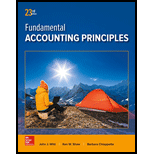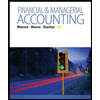
Problem 15−4B
Accounting for long-term investments in securities; with and without signi?cant in?uence
P3 P4
Brinkley Company, which began operations on January 3, 2017, had the following transactions and events in its long- term investments.
2017
Jan. 5 Brinkley purchased 20,000 shares (25% of total) of Bloch’s common stock for $200,500.
Aug. 1 Bloch declared and paid a cash dividend of $1.05 per share.
Dec. 31 Bloch’s net income for 2017 is $82,000, and the fair value of its stock is $11.90 per share.
2018
Aug. 1 Bloch declared and paid a cash dividend of $1.35 per share.
Dec. 31 Bloch’s net income for 2018 is $78,000, and the fair value of its stock is $13.65 per share.
2019
Jan. 8 Brinkley sold all of its investment in Bloch for $375,000 cash.
Part 1
Assume that Brinkley has a signi?cant in?uence over Bloch with its 25% share.
Required
1. Prepare
2. Compute the carrying (book) value per share of Brinkley’s investment in Bloch common stock as reflected in the investment account on January 7, 2019.
3. Compute the net increase or decrease in Brinkley’s equity from January 5, 2017, through January 8, 2019, resulting from its investment in Bloch.
Check {2} Carrying value per share, $9.63
Part 2
Assume that although Brinkley owns 25% of Bloch’s outstanding stock, circumstances indicate that it does not have a signi?cant in?uence over the investee and that it is classi?ed as an available-for-sale security investment.
Required
1. Prepare journal entries to record these transactions and events for Brinkley. Also prepare an entry dated January 8, 2019, to remove any balance related to the fair value adjustment.
2. Compute the cost per share of Brinkley’s investment in Bloch common stock as re?ected in the investment account on January 7, 2019.
3. Compute the net increase or decrease in Brinkley’s equity from January 5, 2017, through January 8, 2019, resulting from its investment in Bloch.
(1) 1/8/2019 Dr. Unrealized Gain-Equity, $72,500
(3) Net increase $222,500
Want to see the full answer?
Check out a sample textbook solution
Chapter 15 Solutions
Fundamental Accounting Principles
- I am trying to find the accurate solution to this general accounting problem with the correct explanation.arrow_forwardI am trying to find the accurate solution to this general accounting problem with appropriate explanations.arrow_forwardHow can I solve this financial accounting problem using the appropriate financial process?arrow_forward
- Can you demonstrate the accurate steps for solving this financial accounting problem with valid procedures?arrow_forwardPlease help me solve this general accounting question using the right accounting principles.arrow_forwardI need help with this general accounting problem using proper accounting guidelines.arrow_forward
- I am trying to find the accurate solution to this general accounting problem with appropriate explanations.arrow_forwardI need guidance with this general accounting problem using the right accounting principles.arrow_forwardHow is the debt-to-equity ratio calculated, and what does it indicate? helparrow_forward
 Financial Accounting: The Impact on Decision Make...AccountingISBN:9781305654174Author:Gary A. Porter, Curtis L. NortonPublisher:Cengage Learning
Financial Accounting: The Impact on Decision Make...AccountingISBN:9781305654174Author:Gary A. Porter, Curtis L. NortonPublisher:Cengage Learning Financial AccountingAccountingISBN:9781305088436Author:Carl Warren, Jim Reeve, Jonathan DuchacPublisher:Cengage Learning
Financial AccountingAccountingISBN:9781305088436Author:Carl Warren, Jim Reeve, Jonathan DuchacPublisher:Cengage Learning Financial & Managerial AccountingAccountingISBN:9781285866307Author:Carl Warren, James M. Reeve, Jonathan DuchacPublisher:Cengage Learning
Financial & Managerial AccountingAccountingISBN:9781285866307Author:Carl Warren, James M. Reeve, Jonathan DuchacPublisher:Cengage Learning Cornerstones of Financial AccountingAccountingISBN:9781337690881Author:Jay Rich, Jeff JonesPublisher:Cengage Learning
Cornerstones of Financial AccountingAccountingISBN:9781337690881Author:Jay Rich, Jeff JonesPublisher:Cengage Learning Intermediate Accounting: Reporting And AnalysisAccountingISBN:9781337788281Author:James M. Wahlen, Jefferson P. Jones, Donald PagachPublisher:Cengage Learning
Intermediate Accounting: Reporting And AnalysisAccountingISBN:9781337788281Author:James M. Wahlen, Jefferson P. Jones, Donald PagachPublisher:Cengage Learning Financial Reporting, Financial Statement Analysis...FinanceISBN:9781285190907Author:James M. Wahlen, Stephen P. Baginski, Mark BradshawPublisher:Cengage Learning
Financial Reporting, Financial Statement Analysis...FinanceISBN:9781285190907Author:James M. Wahlen, Stephen P. Baginski, Mark BradshawPublisher:Cengage Learning





